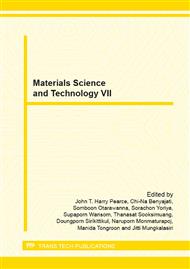p.134
p.143
p.148
p.153
p.158
p.163
p.173
p.177
p.182
Tribological Properties of Titanium Plate Coated with Carbon Nanotubes
Abstract:
This study investigated the tribological property and wear behavior of pure titanium (Ti) plate coated with un-bundled multi-walled carbon nanotubes (MWCNTs). The network-structured MWCNT films were formed on Ti substrate, and their tribological properties were examined by the ball-on-disk wear test equipment under dry sliding condition. SUS304 stainless steel ball was used as a counterpart material in this test. The mean friction coefficient of the Ti plate coated with MWCNTs was remarkably lower and stable compared to the as-received pure Ti plate without any coating films. SEM-EDS analysis showed the network-structured MWCNT films obviously remained after wear test for 3.6 ks in sliding and no seizure phenomena with the SUS304 ball. The above excellent tribological performance was due to CNTs self-lubricant, their bearing effects and the strong metallurgical bonding between Ti plate and MWCNT films by annealing.
Info:
Periodical:
Pages:
158-162
Citation:
Online since:
March 2013
Authors:
Keywords:
Price:
Сopyright:
© 2013 Trans Tech Publications Ltd. All Rights Reserved
Share:
Citation:


